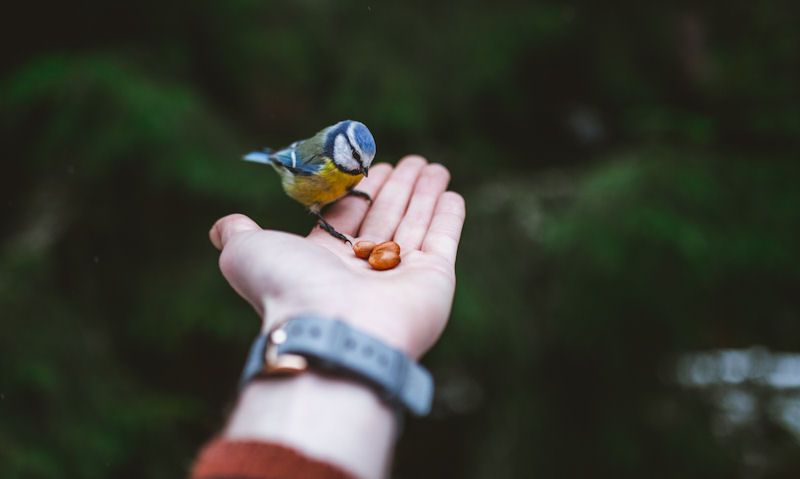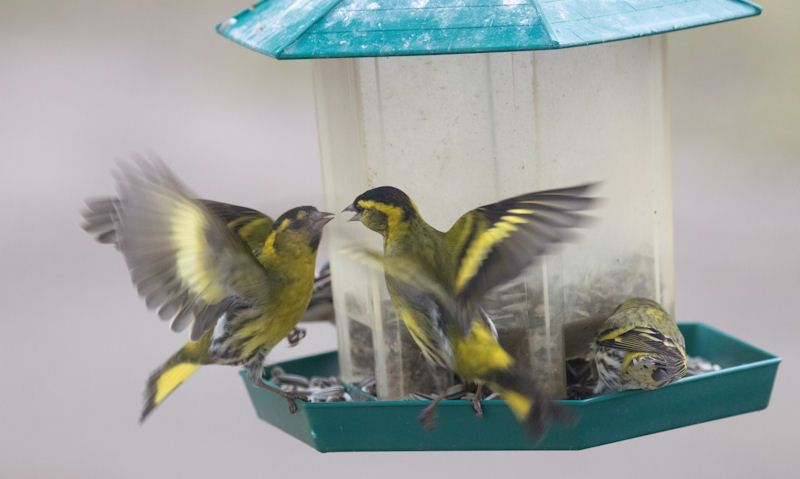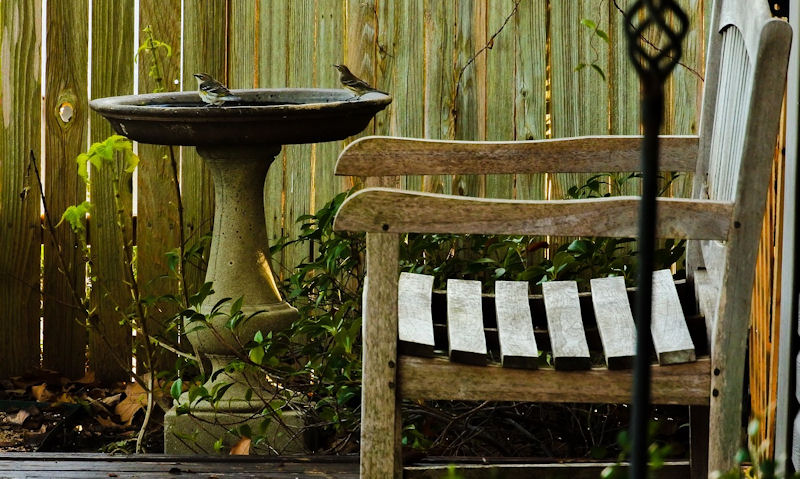How to hand feed wild birds
Rewarding as it is fascinating, as wild birds approach you in your own garden to feed out of your hand, gently resting on your fingers to eat out of the palm of your hand.
Hand feeding wild birds starts with trust, offer them an assortment of there normal food by offering it them in your hand. Likely garden birds to feed are Tits, Sparrows, Nuthatches and Dunnocks. Be patience, well making sure the only source of food in your garden is in you hand.
Would should say take caution whenever handling wildlife, as they're notorious carriers of deceases, so remove clothing if touched and always wash hands.
Depending on the bird, they will land on the palm or finger tips, but always present the feed in the centre creating a cradle to stop food falling out.
Patience, time and enthusiasm is what you need to finally get a Blue Tit, Coal Tit, Sparrow or Dunnock to feed from your hand - with even the occasional Nuthatch.
Well being quite, standing still helps, you may want to try imitation bird noises.
Hand feeding a bird will depend on what ones reside in you garden, so if you've never seen a Nuthatch, they probably are never around to feed.
Read the following advice carefully, as we've taken every care to supply useful tips and tricks, with a few inventive ways to attract wild birds to feed from your hand.
Do I have to worry about deceases
Amongst themselves, wild birds often host a series of nasty parasites, bacteria and viruses which are only is transmittable between various bird species.
Visiting wild birds to your garden with these deceases can include pigeons, starlings and house sparrows.
Well sparrows are a bird that are willing to land on your hand, you must take care to never touch your face - certainly eyes and mouth - and must wash hands aggressively after they touch you.
Heath risks to humans
Always a taboo around wild birds are carriers of deceases, which is very true, but the likelihood of deceases transmitted to people is very rare, and only happens with bird droppings.
Never touch bird poo and if you have wash your hands right away.
Its quite rare you'll get a hand feeding bird pooping on your hand as they are not likely to poo on what they eat.
But it could happen with pigeons, so take extra care with them.
Can birds feet scratch me
Small wild birds are light, gentle but very agile; meaning its always possible they could scratch you with there feet, but they don't mean too.
Remember there's always a chance just as a pet dog or cat would catch when excited.
Bird feet are used to hang upside down to feed off the bird feeder or hold onto nuts to crack open the shell like a woodpecker.
Landing on your calm or wrist, the bird will spread out there feet well naturally searching for crevices to insert there feet in, but always keep your fingers closed to prevent trapping there feet.
If they land on the tips of your fingers you will feel a light grip, so as long as things are all rosy, they will stay firm, but tightly wrapped.
Predatory birds with killing feet are out of the question - including owls, sparrowhawks - as there feet are designed to catch and kill so specialty gloves are required in a safe, controlled environment with experts.
Gloves for protection
If you're concerned about feeding wild birds with your bare hands, you could overcome that issue by simply wearing gloves.
The type of gloves don't really matter, but it shouldn't be every day gloves you wear out and about in the cold weather.
Try to go with a cheap pair that are quite flimsy so you can still feel the touch of the little birds feet.
Successfully attracting a Tit, Dunnock or sparrow to feed out of your hand may not be so rewarding if you can't feel the touch of there feet.
Well the wearing of gloves are not a deterrent to birds, going crazy on design might put them off, or bright colours may discreet the display of food on your palm.
What food to offer
Any feed you have in your feeders will do, but you'll need to make an exception with small garden birds by only offering there favourites.
Take the Tits; they're big feeders of peanuts so ideally you would want to offer that, which is also a good option for sparrows.
Things can get messy if one or more birds take to your hands, but never use your other to tidy things up - it will only scare them away.
Stay with peanuts, seeds and occasional dried mealworms if you dare as they don't create a mess.
Well fat balls would be fed on, think about how you could hold it in a suitable way, other than clenching it to stop its rolling away, its not ideal.
Wild birds can you hand feed
Up to five species of common garden birds will feed out of your hand that you would be most interested in - including a pigeon.
The Tit family, including the Blue and Coal are the biggest takers for hand feeding.
Light and agile, they're perfectly setup little issues for you. Next up is the sparrow who may be more aggressive well eating, before settling.
Then comes the Nuthatches or Dunnock, a rare chance so you'd have to be lucky.
Blue Tit, Coal Tits
Both Blue Tits and Coal Tits are the biggest feeders from hands in the UK, well both sharing an appetite for tasty peanuts, so make sure you always offer these nuts.
Don't fill up the peanut feeder beforehand, make them work for you by offering it up by hand instead.
One of the smallest common British garden birds will feed in the most gentle way, preferring to land on the tips of your fingers than on the palm, so it would be ideal to keep them firmly in place.
Sparrows
House Sparrows would probably feed on peanuts but are big eaters of invertebrates - meaning insects.
So if you have dried mealworms available then use them if you know for certain sparrows are in the garden.
Bit larger but still small, more than one sparrow is likely to approach your hand, and its doesn't matter how you hold the food, just as long as they have clear sight.
Dunnock
Another insect eater is the Dunnock, so use the same method as above and offer up dried mealworms for birds.
Quite approachable bird but very, very agile, so the likelihood of them landing on your hand is slim, but still possible.
You see birds that move around quickly rarely land, or at least not long enough to enjoy.
Nuthatches
Offer up a small helping of bird seeds like nyger to see if that will get the attention of the Nuthatches.
You should be aware if Nuthatches visit your garden regularly then they might feed from your hand, otherwise the chances of one appearing out of thin air is unlikely.
Small and gentle like the Tits, Nuthatches would likely perch on the tips of your fingers or thumb.
Patience is a virtue
On your first try attempting to attract a bird to feed from your hand would probably be unsuccessful one, and as the week goes on no interest would come, but that's completely normal.
You see its all about being at the right place, at the right time. With patience needed by you as you commit more of your time waiting around and trying.
Its never a guarantee a wild bird feeding from your hand, but we can say for certain you may get interest, even if they don't land. So don't get disheartened, be patience and you may get rewarded.
Set a time your willing to wait
Don't just step out into your garden on random times in the day; knowing birds start to feed about 7am, this would be a time to try.
Be prepared and set yourself about 20 to 30 minutes if you can spare, it, though be warned if you're not willing to put in the time, the rewards are not likely to come.
This time you've given yourself should be just as the birds start to arrive at the garden to feed, but we can't say it enough, if the feeders have food - just a little - then they have no reason to come to you.
Be quiet, stay still
At your first attempt hand feeding birds, it would be wise to be very quiet and still as if you're another object in the garden.
The littlest movement would usually result in them flying away or diving into a nearby bush, and well any noise would result in the same - making noises in the first place would stop them coming all together.
Given time, hand feeding wild birds well staying nice and quite will start to bring birds closer, so keep up with this method before abandoning it to soon.
In this time you'll probably be standing up, but remember you're free to sit on a chair, on the wall or on the porch step, find your preferred spot and stick to it every time.
Draw birds with noises
If nothing comes from be quiet, standing or sitting still, then a gentle, friendly bird sound might do it.
No nasty, trying to hard bird calls, just a quiet yet continuous whisle with short break will often be enough.
It shouldn't take to long to realise the sounds you're making are not working, as the birds can be the judge of it by staying away.
Timing matters
Time of the year, month and day all play a part when its the right time to feed birds.
Take the winter for example, where the food is far more sparse due to bad weather, they may be more willing to feed out of your hand.
But with spring and summer, plenty of food in feeders are abound, so it might be more difficult to divert them to you.
Hand feeding in winter
During the winter months food in feeders get hard due to the cold and hanging frost, in many cases lasting weeks on end.
Birds that feed in the winter need access which is tougher when a heavy snowfall covers the feeders.
So with that in mind, and its not possible to feed them any more food in the feeders until the frost has passed, its a good time to offer your hand.
Taking a handful of bird food out of your storage area would be a tempting proposition when attempting to eat the hard fat balls or mealworms is just not possible.
When feeders are empty
Not even a small amount of bird food should be on your bird table, hanging bird feeders or even on the ground.
If sources of food are present they will choose to eat from there, so for the time being keep all feeders empty so they will be more willing to approach you.
Don't starve them by never feeding them, refill the feeders after one or two days before trying again once the food runs out.
Early mornings
Always in the morning birds will start to appear in your garden, and as long as you keep the feeders topped up they will return every time.
So this is the time to try your hand at feeding them.
No need to step outside to early in the morning, as you'll be waiting around for a long time. Instead wait to more birds start appearing then set yourself up.
And as we've mentioned, the feeder must be empty.
When hand feeding birds don't work
Often you'll have to use ingenious ways to tempt the birds to feed off your hand, but what might help is the use of items.
Rather then offering your bare hands, wild birds may be more interested in landing on something they feel comfortable with.
This item would be something you're holding, which should have surface suitable to hold food, but feel natural to birds.
Use a board with a pile of food
Take an old piece of wood out of the shed, no bigger than say a small chopping board well holding with both hands.
This board or plank of wood could serve up a mixture of food well it stays put in the middle, without rolling off.
If birds do land on it they will prefer to stay around the edges, so make sure the food is not to central, or to close to your stomach.
Offer your hand with hanging feeder
Take the smallest bird feeder you have in the garden and hold that up with your hand as if you're a feeding station pole.
At first they may not want to feed out of your hands right away, but it would sure be a good way to gain there trust.
If by holding up the smallest feeder by hand encourages birds to feed that way, don't do it right away but given time offer out your other hand with food in your calm, as they just might hop over.
Hand feeding pigeons is easy
People love pigeons just as much as small garden birds, so well we focus primarily on a common hand feeding birds, we mustn't forget the humble pigeon.
Take all our advice we've outlined previously as it could be used to attract pigeons to feed.
Wood pigeons in garden
Likely species of pigeon in your garden would be the wood pigeon, they're often pests that need to be kept away from the bird feeder, so will be willing to feed out of your hand more than small garden birds.
Often nesting near your home in the tree across the way or around the block, they will need feeding and would be willing to land on your arm to feed out of the palm, or walk up to you as you offer them your hand.
Pigeons quite often can't feed from feeders as they're not small and agile enough, so it would be a good time to keep them from feeding off the feeder by feeding them yourself.
Don't waste the food, if they don't bite, throw the feed on the ground.
Head into town
If all else fails in the garden and you're still desperate to feed wild pigeons from your hand, then why not head into town and attempt a pigeon to land on your hand.
If anything they will certainly be happy to approach you before eating out of your hand well on the ground still.
People who enjoy feeding birds - especially tourists - prefer to do so using gloves, so take our advice on wearing gloves to feeds bird by using a cheap pair that can be disposed of.


